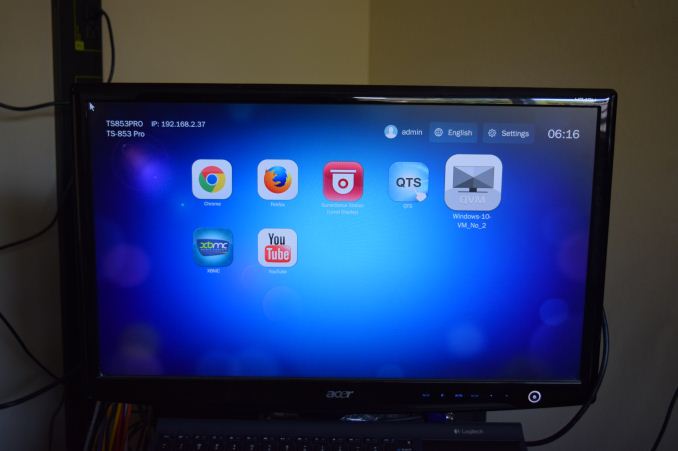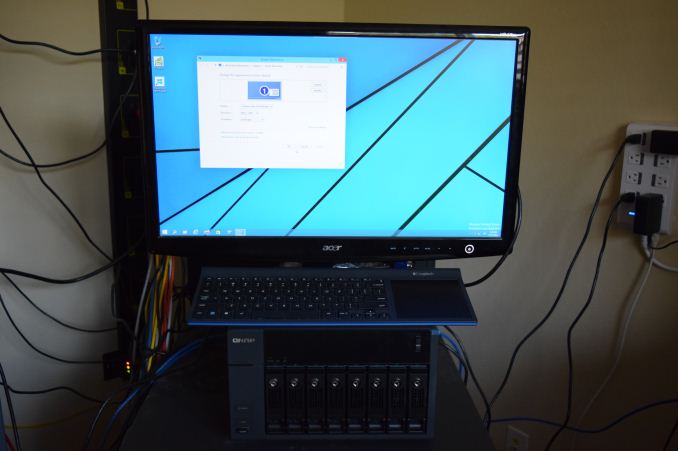QNAP TS-853 Pro 8-bay Intel Bay Trail SMB NAS Review
by Ganesh T S on December 29, 2014 7:30 AM ESTQNAP's HD Station - QvPC Explored
Over the last few years, QNAP has been introducing various interesting packages for their QTS operating system. XBMC was one of the first to take advantage of the HDMI display output on their NAS units. Slowly, a few other packages such as web browsers, NAS management interfaces and YouTube were introduced. Recently, QNAP decided to bundle all these packages under the Hybrid Desk Station (HD Station) moniker.
The ability to interact with the NAS using a keyboard and a mouse brought it closer to a traditional PC for the average consumer. Virtualization Station was the final piece in the puzzle. QNAP added an option to display the console of each VM on the display output desktop (a QVM option) in the Virtualization Station settings. This enables end users to interact not only with the QTS desktop, but also with a Windows or Ubuntu VM as if it was running on a physical machine.
QNAP's HD Station Interface with QVM Activated
Recognizing the big leap made in HD Station using QVMs, QNAP has opted to do a branding exercise - QvPC - for this feature set. In addition to QVMs, HD Station also includes a local output for the tracked surveillance cameras, XBMC with HD audio bitstreaming and other miscellaneous features. QNAP's product page for HD Station adds more marketing detail to what we have covered above.
Windows 10 on a QNAP TS-853 Pro-8G - QvPC
Our usual NAS evaluation routine doesn't load up the NAS with non-NAS aspects while processing benchmarks. For the TS-853 Pro-8G, we did one pass with all four network links bonded and no extra packages active. However, with running VMs being a very attractive feature of the TS-x53 Pro series, we added two sets of benchmarks for the multi-client scenarios after configuring two Windows 10 VMs (two cores, 2 GB RAM and one dedicated network link each). This configuration left the other two network ports free for bonding / external traffic. The CPU cores themselves had to be shared between the VMs and the main NAS tasks (as all four cores ended up getting allocated to the VMs).
- 1 QVM: A Windows 10 VM with QVM configured was activated. PC Mark 8's 'Work' workload was run in a loop with HDMI output enabled, while the rest of the NAS was subject to storage traffic over the bonded network links
- 2 VMs: QVM was de-activated. Two Windows 10 VMs were configured for access via Remote Desktop. PC Mark 8's 'Work' workload was run in a loop on both VMs, while the rest of the NAS was subject to storage traffice over the bonded network links.
In addition to the above Virtualization Station configuration, we also found an interesting caching aspect in QTS. Our benchmarks are processed after turning off the write cache (EXT4 delay allocation) for all NAS units. However, QTS, in addition to the EXT4 delay allocation, has an additional system cache setting at the volume level. The large amount of RAM in the system (8 GB) also skewed the results quite a bit with the system cache settings enabled. QNAP is also one of the first COTS NAS vendors to support SMB 3.0. Obviously, this is available only for Windows 8 and Windows Server 2012 R2 and later operating systems. We tested out SMB 3.0 with a Windows 8 VM in our NAS testbed. In the rest of the review, we try to address as many different combinations as possible in the benchmarks.












58 Comments
View All Comments
chocosmith - Tuesday, December 30, 2014 - link
just to add, as others stated its expensive for the "ram" upgrade. I took out the 2gb that came with it and install 8gb (2*4gb) much cheaper. a guy on the forums managed to get 16gb working (even though the intel chip says that it can't handle it)Adrian3 - Tuesday, December 30, 2014 - link
I'm using an Intel NUC as my Media Box - with MediaBrowser. It's fantastic (and tiny). The fan can get a bit loud if it's transcoding, but I have it behind a cabinet door, so I can't hear it. And anyway, 99% of the stuff I watch is direct played not transcoded, and it's very quiet when doing that.ganeshts - Tuesday, December 30, 2014 - link
I am also not bullish on using a NAS as a HTPC, which is why I don't give too much importance to the HTPC / XBMC aspect. A NAS should fulfil its primary duties - serving files well, and doing real-time transcoding if necessary. Anything else is just gravy on the top. VM capabilities are appreciated - particularly if the VM works on data that is on the NAS itself. Other HTPC aspects - not so much - this is why I think Synology is not missing much by avoiding HDMI output on their NAS units.shaunpugh - Tuesday, December 30, 2014 - link
The thing all of these types of review seem to miss is support. Try logging a support call and see what kind of response you get. Synology might have a perceived 'win' in this review but their support, at least in the UK, is non-existent.Adrian3 - Tuesday, December 30, 2014 - link
I had a problem with my current (older version) 8 bay Qnap which was causing a streaming pause when I started to copy new data to it. The support guys were great. They spent quite a bit of time troubleshooting with me logged in using Teamviewer. They eventually supplied a firmware patch, which was eventually incorporated into an official firmware release.intiims - Tuesday, December 30, 2014 - link
All of these devices are very expensive.. And all of them are almost the same..Read about Hard Drives on http://www.hddmag.com/
CiccioB - Sunday, January 4, 2015 - link
I would like to add my vote for an article of NAS targeted to home users.It is nice to read about these articles, but a review of a $1000 NAS, disks excluded, is quite useless for almost everyone.
The market offers a lot of solutions for home users and it is not really easy to understand which is the one that is the right one for price/performance/features and most of all, easy of use.
For example you have never reviewed a single WD cloud solution(1, 2 or 4 disks) that are cheap and may be enough for most of the users if they only knew what these devices can and cannot do.
Comparing them directly with QNAP/Synology/Buffalo more expensive solutions may be an indication if all those added features and setup+maintenance time are really worth what they cost.
Thanks in advance
Evadman - Monday, January 5, 2015 - link
I have a TS-853 Pro 8G; currently populated with eight 3TB HGST drives; 7 in RAID6, one hot spare. I got it to replace a power hungry server that was using a Adaptec 52445 controller with 20 drives. I also used the server as a VM host for testing so finding a NAS that supported a VM really helped me choose the QNAP.My old server could transfer around 200MB/s while the QNAP is at around 115 MB/s which is acceptable for my use case. The VM setup is decent, but transferring a VM from a Windows Server to the QNAP box is a PITA. Not QNAP's fault really, that's a windows proprietary issue with the VHD setup. So far, no issues running a VM. As far as I can tell, the board will support another 8 GB of memory, but QNAP doesn't support it. I haven't yet purchased more memory to test that though. It would help with the VM hosting. The VM station only supports 2 administrator accounts which can be trouble for SMBs.
As a note, this review lists the 853 can only support 2 VM's at a time. That is incorrect. In July Virtualisation Station 1.1v2088 and later no longer have a hard limitation for the number of concurrent active VMs. As long as there is memory and CPU available, have at creating more VM's. That's why I want more than 8GB of memory.
The only worry I really have with QNAP is that their support seems not-so-good. If you read though the forum it is filled with issue reports without response from QNAP. As a power user, I suppose that is alright, but for a SMB, especially one without an IT professional, that would worry me greatly. What happens if the box breaks and you need to swap the drives to a replacement box? What if there is a config issue you can't fix? Defiantly worrying. The forum has a few non-QNAP people that really know what they are doing though.
Also, something I researched and tried out was QNAP's hook into amazon Glacier. QNAP really messed up the beta of Glacier support for Amazon, which is probably why it isn't available in their app system yet. It is not optomized at all for Glacier. My NAS has something like 1.7 million files on it. Uploading them to Glacer in the way the app does it would cost $340 just to upoad. The app doesn't warn the user that it isn't optmimized or that it will cost so much. Download is even worse at something like a grand because of the coding. They really need to understand how to work with 3rd party groups because other apps have similar issues.
the NAS itself has been great for the core features though. A bit pricy but so far I am happy with it.